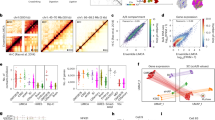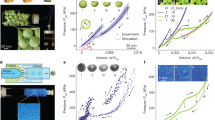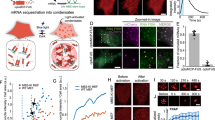Abstract
One defining goal of synthetic biology is the development of engineering-based approaches that enable the construction of gene-regulatory networks according to ‘design specifications’ generated from computational modelling1,2,3,4,5,6. This approach provides a systematic framework for exploring how a given regulatory network generates a particular phenotypic behaviour. Several fundamental gene circuits have been developed using this approach, including toggle switches7 and oscillators8,9,10, and these have been applied in new contexts such as triggered biofilm development11 and cellular population control12. Here we describe an engineered genetic oscillator in Escherichia coli that is fast, robust and persistent, with tunable oscillatory periods as fast as 13 min. The oscillator was designed using a previously modelled network architecture comprising linked positive and negative feedback loops1,13. Using a microfluidic platform tailored for single-cell microscopy, we precisely control environmental conditions and monitor oscillations in individual cells through multiple cycles. Experiments reveal remarkable robustness and persistence of oscillations in the designed circuit; almost every cell exhibited large-amplitude fluorescence oscillations throughout observation runs. The oscillatory period can be tuned by altering inducer levels, temperature and the media source. Computational modelling demonstrates that the key design principle for constructing a robust oscillator is a time delay in the negative feedback loop, which can mechanistically arise from the cascade of cellular processes involved in forming a functional transcription factor. The positive feedback loop increases the robustness of the oscillations and allows for greater tunability. Examination of our refined model suggested the existence of a simplified oscillator design without positive feedback, and we construct an oscillator strain confirming this computational prediction.
This is a preview of subscription content, access via your institution
Access options
Subscribe to this journal
Receive 51 print issues and online access
$199.00 per year
only $3.90 per issue
Buy this article
- Purchase on Springer Link
- Instant access to full article PDF
Prices may be subject to local taxes which are calculated during checkout




Similar content being viewed by others
References
Hasty, J., Dolnik, M., Rottschäfer, V. & Collins, J. J. Synthetic gene network for entraining and amplifying cellular oscillations. Phys. Rev. Lett. 88, 148101 (2002)
Hasty, J., McMillen, D. & Collins, J. J. Engineered gene circuits. Nature 420, 224–230 (2002)
Tyson, J., Chen, K. & Novak, B. Sniffers, buzzers, toggles and blinkers: dynamics of regulatory and signaling pathways in the cell. Curr. Opin. Cell Biol. 15, 221–231 (2003)
Sprinzak, D. & Elowitz, M. B. Reconstruction of genetic circuits. Nature 438, 443–448 (2005)
Endy, D. Foundations for engineering biology. Nature 438, 449–453 (2005)
Andrianantoandro, E., Basu, S., Karig, D. K. & Weiss, R. Synthetic biology: new engineering rules for an emerging discipline. Mol. Syst. Biol. 2, 2006.0028 (2006)
Gardner, T. S., Cantor, C. R. & Collins, J. J. Construction of a genetic toggle switch in Escherichia coli . Nature 403, 339–342 (2000)
Elowitz, M. B. & Leibler, S. A synthetic oscillatory network of transcriptional regulators. Nature 403, 335–338 (2000)
Atkinson, M. R., Savageau, M. A., Myers, J. T. & Ninfa, A. J. Development of genetic circuitry exhibiting toggle switch or oscillatory behavior in Escherichia coli . Cell 113, 597–607 (2003)
Fung, E. et al. A synthetic gene-metabolic oscillator. Nature 435, 118–122 (2005)
Kobayashi, H. et al. Programmable cells: interfacing natural and engineered gene networks. Proc. Natl Acad. Sci. USA 101, 8414–8419 (2004)
You, L., Cox, R. S., Weiss, R. & Arnold, F. H. Programmed population control by cell-cell communication and regulated killing. Nature 428, 868–871 (2004)
Barkai, N. & Leiber, S. Circadian clocks limited by noise. Nature 403, 267–268 (2000)
Lutz, R. & Bujard, H. Independent and tight regulation of transcriptional units in Escherichia coli via the LacR/O, the TetR/O and AraC/I1-I2 regulatory elements. Nucleic Acids Res. 25, 1203–1210 (1997)
Lee, S. K. et al. Directed evolution of AraC for improved compatibility of arabinose- and lactose-inducible promoters. Appl. Environ. Microbiol. 73, 5711–5715 (2007)
Bliss, R. D., Painter, P. R. & Marr, A. G. Role of feedback inhibition in stabilizing the classical operon. J. Theor. Biol. 97, 177–193 (1982)
Bratsun, D., Volfson, D., Tsimring, L. S. & Hasty, J. Delay-induced stochastic oscillations in gene regulation. Proc. Natl Acad. Sci. USA 102, 14593–14598 (2005)
Rateitschak, K. & Wolkenhauer, O. Intracellular delay limits cyclic changes in gene expression. Math. Biosci. 205, 163–179 (2007)
Mackey, M. & Glass, L. Oscillation and chaos in physiological control systems. Science 197, 287–289 (1977)
Jaeger, J. & Reinitz, J. On the dynamic nature of positional information. Bioessays 28, 1102–1111 (2006)
Faith, J. et al. Large-scale mapping and validation of Escherichia coli transcriptional regulation from a compendium of expression profiles. PLoS Biol. 5, e8 (2007)
Andersen, J. B. et al. New unstable variants of green fluorescent protein for studies of transient gene expression in bacteria. Appl. Environ. Microbiol. 64, 2240–2246 (1998)
Cookson, S., Ostroff, N., Pang, W. L., Volfson, D. & Hasty, J. Monitoring dynamics of single-cell gene expression over multiple cell cycles. Mol. Syst. Biol. 1, 2005.0024 (2005)
Gillespie, D. T. Exact stochastic simulation of coupled chemical-reactions. J. Phys. Chem. 81, 2340–2361 (1977)
Hasty, J. et al. Computational studies of gene regulatory networks: in numero molecular biology. Nature Rev. Genet. 2, 268–279 (2001)
Ozbudak, E., Thattai, M., Lim, H., Shraiman, B. & van Oudenaarden, A. Multistability in the lactose utilization network of Escherichia coli . Nature 427, 737–740 (2004)
Wang, X., Hao, N., Dohlman, H. & Elston, T. Bistability, stochasticity, and oscillations in the mitogen-activated protein kinase cascade. Biophys. J. 90, 1961–1978 (2006)
Bennett, M. et al. Metabolic gene regulation in a dynamically changing environment. Nature 454, 1119–1122 (2008)
Gerland, U., Moroz, J. & Hwa, T. Physical constraints and functional characteristics of transcription factor-DNA interaction. Proc. Natl Acad. Sci. USA 99, 12015–12020 (2002)
Groisman, A. et al. A microfluidic chemostat for experiments with bacterial and yeast cells. Nature Methods 2, 685–689 (2005)
Acknowledgements
We thank H. Bujard, C. Yang, and Z. Zhang for gifts of reagents, and D. Volfson and M. Simpson for discussions. This work was supported by grants from the National Institutes of Health (GM69811-01) and the US Department of Defense.
Author Contributions J.S. and J.H. designed the oscillator circuits, and J.S. constructed the circuits. S.C. performed the microscopy experiments, and J.S. and S.C. performed the flow cytometry experiments. S.C., L.S.T. and J.H. performed the single-cell data analysis. M.R.B., W.H.M. and L.S.T. performed the computational modelling. All authors wrote the manuscript.
Author information
Authors and Affiliations
Corresponding author
Supplementary information
Supplementary Information
This file contains Supplementary Materials and Methods, Supplementary Figures 1-22 and Supplementary References (PDF 9422 kb)
Supplementary Movie 1
Supplementary Movie file 1 shows a timelapse microscopy of JS011 cells continuously induced with 0.7% arabinose and 2 mM IPTG at 37 C. The brightfield image is shown in grey, and fluorescence is shown in green. Total time of movie is 228 min with a sampling rate of one image every 3 min. (MOV 1787 kb)
Supplementary Movie 2
Supplementary Movie file 2 shows a timelapse microscopy of JS011 cells continuously induced with 0.7% arabinose and 0 mM IPTG at 37 C. The brightfield image is shown in grey, and fluorescence is shown in green. Total time of movie is 219 min with a sampling rate of one image every 3 min. (MOV 3754 kb)
Supplementary Movie 3
Supplementary Movie file 3 shows a timelapse microscopy of JS011 cells continuously induced with 0.7% arabinose and 0.25 mM IPTG at 37 C. The brightfield image is shown in grey, and fluorescence is shown in green. Total time of movie is 222 min with a sampling rate of one image every 3 min. (MOV 2176 kb)
Supplementary Movie 4
Supplementary Movie file 4 shows a timelapse microscopy of JS011 cells continuously induced with 0.7% arabinose and 0.5 mM IPTG at 37 C. The brightfield image is shown in grey, and fluorescence is shown in green. Total time of movie is 210 min with a sampling rate of one image every 3 min. (MOV 1033 kb)
Supplementary Movie 5
Supplementary Movie file 5 shows a timelapse microscopy of JS011 cells continuously induced with 0.7% arabinose and 0.75 mM IPTG at 37 C. The brightfield image is shown in grey, and fluorescence is shown in green. Total time of movie is 268 min with a sampling rate of one image every 2 min. (MOV 3717 kb)
Supplementary Movie 6
Supplementary Movie file 6 shows a timelapse microscopy of JS011 cells continuously induced with 0.7% arabinose and 1 mM IPTG at 37 C. The brightfield image is shown in grey, and fluorescence is shown in green. Total time of movie is 176 min with a sampling rate of one image every 2 min. (MOV 2029 kb)
Supplementary Movie 7
Supplementary Movie file 7 shows a timelapse microscopy of JS011 cells continuously induced with 0.7% arabinose and 5 mM IPTG at 37 C. The brightfield image is shown in grey, and fluorescence is shown in green. Total time of movie is 246 min with a sampling rate of one image every 3 min. (MOV 1647 kb)
Supplementary Movie 8
Supplementary Movie file 8 shows a timelapse microscopy of JS011 cells continuously induced with 0.7% arabinose and 10 mM IPTG at 37 C. The brightfield image is shown in grey, and fluorescence is shown in green. Total time of movie is 204 min with a sampling rate of one image every 3 min. (MOV 1538 kb)
Supplementary Movie 9
Supplementary Movie file 9 shows a timelapse microscopy of JS011 cells continuously induced with 0.7% arabinose and 2 mM IPTG at 25 C. The phase contrast image is shown in grey, and fluorescence is shown in green. Total time of movie is 702 min with a sampling rate of one image every 3 min. (MOV 3568 kb)
Supplementary Movie 10
Supplementary Movie file 10 shows a timelapse microscopy of JS011 cells upon initiation of induction with0.7% arabinose and 2 mM IPTG at 37 C. The brightfield image is shown in grey, and fluorescenceis shown in green. Total time of movie is 75 min with a sampling rate of one image every 3 min. Note the initial synchrony of the fluorescence response. (MOV 1078 kb)
Supplementary Movie 11
Supplementary Movie file 11shows a timelapse microscopy of JS013 cells continuously induced with 0.6mM IPTG at 37 C. The phase-contrast image is shown in grey, and fluorescence is shown in green. Total time of movie is 210 min with a sampling rate of one image every 3 min. (MOV 2084 kb)
Supplementary Movie 12
Supplementary Movie file 12 shows a timelapse microscopy of MG1655Z1/pZE12-yemGFP-ssrA cells continuously induced with 2 mM IPTG at 37 C. These cells express GFP from the pLlacO-1 promoter and express LacI constitutively. There is no feedback control of GFP expression in this strain. The phase-contrast image is shown in grey, and fluorescence is shown in green. Total time of movie is 252 min with a sampling rate of one image every 3 min. (MOV 2966 kb)
Rights and permissions
About this article
Cite this article
Stricker, J., Cookson, S., Bennett, M. et al. A fast, robust and tunable synthetic gene oscillator. Nature 456, 516–519 (2008). https://doi.org/10.1038/nature07389
Received:
Accepted:
Published:
Issue Date:
DOI: https://doi.org/10.1038/nature07389
Comments
By submitting a comment you agree to abide by our Terms and Community Guidelines. If you find something abusive or that does not comply with our terms or guidelines please flag it as inappropriate.



